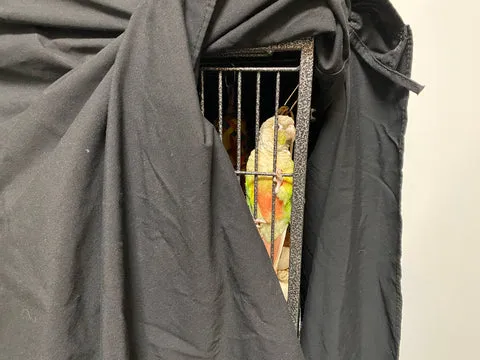Are you wondering whether to cover your bird’s cage at night? This is one of the most common questions bird owners ask during vet consultations. If your feathered friend is territorial, biting at anyone near the cage, napping excessively during the day, obsessed with blankets, or spending too much time at the bottom of the cage despite a clean bill of health from the vet, a cage cover might be the culprit.
Many well-meaning owners use cage covers thinking they promote better sleep, but they often lead to more behavioral issues. As a bird care expert with years of experience treating parrots, cockatoos, and other species, I’ve seen firsthand how these covers exacerbate problems rather than solve them. Instead of darkness mimicking a natural nest, they create stress and health risks. Let’s dive into why ditching the cage cover is the best choice for your bird’s well-being.
 A colorful bird perched inside its uncovered cage, looking alert and healthy
A colorful bird perched inside its uncovered cage, looking alert and healthy
Common Signs You’re Over-Relying on Cage Covers
Before we get into the downsides, consider these red flags that scream “misuse of cage covers”:
- Territorial aggression: Your bird lunges or bites when you approach the cage, even for routine tasks like refreshing food or water.
- Daytime fatigue: Long naps during daylight hours suggest poor nighttime rest.
- Fabric fixation: Endless shredding of blankets or clothes, indicating a nesting instinct gone wrong.
- Bottom-dwelling behavior: Lingering at the cage floor without illness, a sign of discomfort or stress.
These behaviors often stem from inconsistent covering routines, which confuse birds rather than calm them. For friendliest birds like African greys or cockatiels, maintaining a stable environment is key to preventing such issues.
Reason #1: Misuse as a Quick Fix for Screaming
The biggest problem? Owners toss a cover over a noisy bird to silence it, treating it like punishment. Birds don’t perceive darkness as discipline—they experience isolation and anxiety. This “domino effect” worsens screaming, plucking, and other psychological issues. According to avian behaviorists, consistent positive reinforcement, like quiet time training, works far better than enforced blackout.
Imagine locking yourself in a dark room every time you raise your voice—it’s counterproductive and unkind. Vets at the Association of Avian Veterinarians (AAV) emphasize natural light cycles over forced sleep.
Reason #2: Triggering Hormonal Nightmares
Cage covers turn your bird’s home into a cozy, dark nest, sparking hormonal surges. Birds start defending “their” space fiercely, shredding fabrics for bedding, and exhibiting mating behaviors like regurgitation or screaming at dawn. Species like African lovebirds are especially prone, leading to aggression and feather damage.
In my practice, I’ve treated countless cases where covers mimicked breeding season year-round. Natural dusk-to-dawn lighting prevents this hormonal rollercoaster, keeping your pet balanced.
Reason #3: Questionable Sleep Quality
Does your bird truly sleep under the cover? Without audio cues like soft chatter or movement, you can’t tell. Many birds stay awake, stressed by muffled sounds from TVs or household noise. Even if they doze, the sleep is fragmented—not the deep, restorative 10-12 hours parrots need.
Research from the World Parrot Trust shows birds thrive on gradual light dimming, similar to wild roosting. Covers disrupt this, leading to daytime lethargy.
Reason #4: Serious Safety Hazards
Safety should top every list, yet it’s often overlooked. Birds, particularly cockatoos, chew through fabrics, ingesting threads that cause crop impactions, intestinal blockages, or even fatal obstructions requiring surgery. Entanglement risks are real too—feet or wings caught in unraveling material.
The AAV reports fabric ingestion as a leading emergency in pet birds. Opt for a sturdy 3 feet bird cage without covers to eliminate these dangers.
Reason #5: Blocked Airflow and Respiratory Risks
Birds have ultra-sensitive lungs; covers trap dust, dander, and poor ventilation. Macaws and other large parrots, already dust-prone, face heightened risks of aspergillosis or other infections. Fresh airflow is non-negotiable overnight.
Avian specialists recommend rooms with HEPA filters and open cages for optimal respiratory health.
For owners seeking budget-friendly options, check out cheap talking birds that adapt well to cover-free setups.
Better Alternatives for Quality Bird Sleep
Skip covers entirely. Aim for 10-12 uninterrupted hours in a dedicated setup:
- Sleeper cage: Move to a quiet, dark room away from traffic.
- Blackout curtains: On windows in the bird room for natural darkness.
- Timers: Automate lights to mimic sunset/sunrise, as we do in our clinic.
These promote genuine rest without risks. Monitor with a night-vision camera if needed.
In summary, covering your bird’s cage at night creates far more harm—hormonal chaos, health dangers, and poor sleep—than good. Prioritize safety, airflow, and natural rhythms for a happier pet. Consult your avian vet for personalized advice, and explore mynah bird for sale options that thrive in open environments.
References:
- Association of Avian Veterinarians (AAV): Guidelines on Bird Housing.
- World Parrot Trust: Sleep and Light Cycle Studies.
